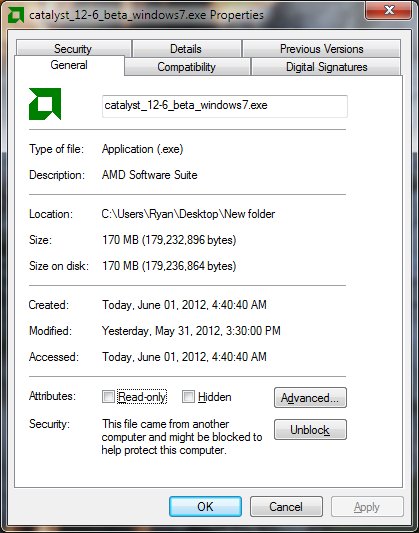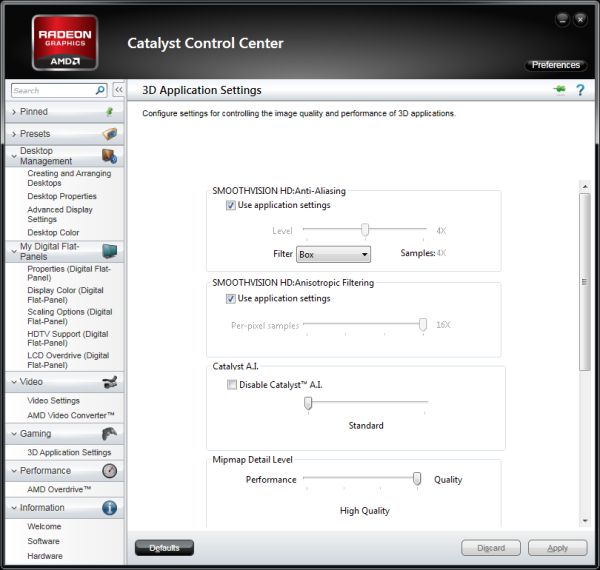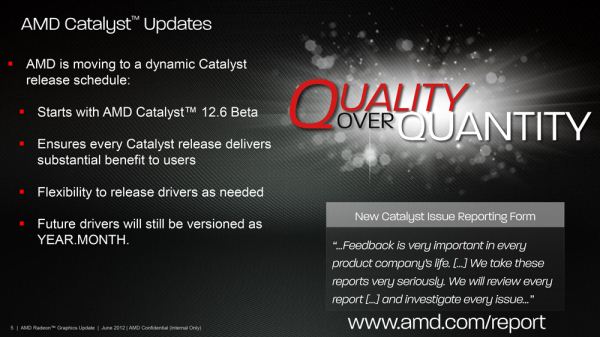AMD Discontinues Monthly Driver Updates, Releases Catalyst 12.6 Beta
by Ryan Smith on June 1, 2012 9:00 AM ESTThe last month or so has been one of transition for AMD’s Catalyst driver crew. Alongside the launch of AMD’s Trinity APU – complete with what’s only AMD’s 2nd VLIW4 GPU – AMD has also been hard at work on preparing their next Windows 8 drivers, and on the development side of things AMD also put plans into motion to move their DX10 GPU families to legacy status. Capping this off, AMD’s driver team is embarking on one more change, and for long-time AMD followers it’s going to be a doozy.
For the better part of a decade now AMD (née ATI) has released new WQHL-certified video drivers on a monthly basis. In principle this enables AMD to offer driver updates on a predictable schedule, and to spread out major driver changes over a few versions of the driver. In practice this is exactly how things have worked up until the last couple of years, which is why we’ve been fans of AMD’s driver update schedule for the longest time.

ATI Catalyst 3.8
With that said, that time has come to a close. AMD has announced that starting with Catalyst 12.6 AMD will be ceasing their monthly driver update schedule in favor of releasing drivers on a dynamic/as-needed basis, effectively taking up NVIDIA’s driver release schedule. Instead of 12 monthly WHQL releases plus a smattering of beta and hotfix drivers, AMD will have what we’d estimate to be around half as many WHQL releases alongside an unknown number of beta driver releases. It’s a significant change for AMD’s Catalyst crew and one we’re glad to see they’re making.
Why? As we briefly mentioned before, the benefits of AMD’s monthly driver release schedule were realized in practice for quite some time, but only up until the last couple of years. Starting around the release of the HD 5000 series though those benefits became harder to realize and less meaningful. The issue is at its basic level one of complexity – AMD’s drivers continue to grow in size and complexity, with the latest release weighing in at 170MB. Video drivers have effectively eclipsed Windows 95 in complexity and size in the last couple of years, which reflects the fact that these devices really have become processors, complete with all the intricacies of code compilation and scheduling, and basically in need of a mini-OS just to run them.

The result has been that AMD (and NVIDIA too) have both seen their driver development schedules become more drawn out. For AMD this has meant fewer major driver branches are released in any given year as it takes them longer to research, develop, and assemble the various optimizations and features that are added to their drivers. Consequently the need to release drivers on a monthly basis has led to some driver releases that bring few if any changes, as AMD has no new additions to that driver branch as they work on the next branch. In other words, AMD’s monthly commitment meant AMD had to release drivers whether they had something new or not.
Really this branch problem came to a head in the later part of last year with AMD’s disastrous October driver releases where they ended up with several different drivers being released in the same month; a regular Catalyst release, a BF3 release, and a Rage release that didn’t contain the BF3 improvements. Even without a fixed driver release schedule AMD will still have driver branches and the need to manage the development of multiple branches at once – that’s just the reality of this kind of software development – but it will free up resources that previously needed to be committed to the monthly driver, and in all likelihood it will make project management easier for AMD by making it push major development along a single branch (avoiding a BF3/Rage situation).
As it stands AMD has already missed one monthly driver drop with Catalyst 12.2 (the first regular driver in the 7000 series branch), and AMD will have missed another monthly driver drop with 12.5, which missed its May deadline. It’s clear that thanks in large part to these jumps in complexity and development time that monthly driver releases have become unsustainable for AMD, and behind the scenes we’ve been prodding AMD to move to a dynamic schedule for that exact reason. This makes us all the more glad to see that rather than foolishly try to keep up with this schedule that they’re backing off from trying to release so many drivers.

Modern Catalyst Control Center
However it would be remiss of us to not point out a second, more practical reason for this change too: a reduced necessity. Prior to 2010, full Catalyst driver releases were the only way for AMD to release any kind of driver change. That changed with Catalyst 10.2, which saw the introduction of Catalyst Application Profiles (CAPs). CAPs were primarily created to ease the distribution of new game profiles for Crossfire, but in some cases more general single-GPU problems can be fixed in those profiles. By manipulating the various compatibility settings in their profiles AMD can fix some issues without requiring a driver update, such as CAP 12.4-2 which improved the performance of Max Payne 3 for both single video cards and Crossfire configurations. Larger issues still require a full driver release of course, but compared to years before the advent of CAPs there’s definitely a reduced need thanks to the separation of driver and profile.
Going Forward
As we stated earlier, AMD will be moving to a dynamic/as-needed schedule for driver releases. It’s their hope – as it is ours – that they’ll be able to further improve on the quality and meaningfulness of Catalyst driver releases. Certainly this will cut out the release of near-useless Catalyst drivers, whereas quality as always remains to be judged. Realistically AMD’s most immediate goal should be to do a better job of getting drivers out for major new games as necessary, as that’s something they’ve particularly struggled with and is the thing the new schedule should help the most with by freeing up resources.
To that end the Catalyst 12.6 driver, released in beta form today, will be the first such driver release. We haven’t had a chance to evaluate these drivers in depth yet, but they are from AMD’s latest driver branch and should contain the typical assortment of performance improvements and bug fixes that we’ve come to expect from a major Catalyst release.
Also, it should be noted that while AMD is changing their release schedule their naming schedule is not changing. Catalyst drivers will still be named by [Year].[Month], which unfortunately means there are going to be holes in AMD’s numbering scheme. A month without a driver will simply be empty, so they could go from 12.6 to 12.8, for example. Importantly for non-technical users however this means that they maintain the date in the driver number, making it easy to tell whether a driver is recent or not.
On that note, the one thing AMD hasn’t changed so far but bears mentioning as something we’d like to see changed is AMD’s website. It has always been difficult to find AMD’s beta drivers from inside their website, a problem that is only going to become worse with the change in the release schedule. AMD needs to use this opportunity to change their site so that beta drivers are as easy to find as WHQL drivers, something that quite frankly NVIDIA has done a solid job of.
Finally, alongside the change to their driver release schedule AMD is also instituting a new driver report form to replace the older Catalyst Crew Feedback Form, which is being called the AMD Issue Report Form. The goal is the same, but AMD is moving to this new form in an attempt to gather better feedback from users than what the old form collected. If nothing else, we hope that AMD does a better job of keeping the form visible, as there seems to have been a lot of AMD users that simply never knew about the Catalyst Crew form.
Addendum: We've been informed by AMD that with the release of the Catalyst 12.6 betas, Catalyst 12.5 has been canceled entirely. 12.6 is what 12.5 would have been, and this has special significance for AMD's DX10 generation GPUs. 12.5 was supposed to be the last monthly Catalyst release that supported those GPUs but Catalyst 12.6 beta doesn't support them. So it's not clear when DX10 GPU owners will see a new driver; if this is the start of AMD's "quarterly" update cycle, then it may be a few months, making 12.4 the final driver for the time being.











77 Comments
View All Comments
g101 - Sunday, June 10, 2012 - link
What a ****ing idiot.You should honestly of been banned months (or maybe years) ago. Those whining about 10.1 multi-threaded support: seriously? Are you that incredibly ignorant or just playing dumb?
The level of understanding from cogburn and his crew is incredibly insufficient. Angering, in fact.
Spjut - Sunday, June 10, 2012 - link
If you weren't incredibly ignorant(or just playing dumb), you would perhaps come to understand that some of us don't like it when our hardware is capable of something but doesn't get the support for it.Is it fair that Nvidia's earliest DX10 cards have gotten multithreaded support, while AMD's more advanced DX10.1 cards never will? Of course some of us are pissed.
If you have an AMD DX11 card you might as well get pissed too, because they haven't gotten support for it either right now.
Add also to that that AMD's Windows 8 driver for these "legacy" will be the "In-the-box AMD Graphics driver". Since when has such a driver ever included the CCC?
Nvidia's Windows 8 driver however, says it's supported even on the Geforce 6 series!
tecknurd - Saturday, June 2, 2012 - link
I have used ATI graphics in the past and their drivers and software is pathetic from a reputable company. The drivers crash the system when Windows runs. The software that they include for All-in-Wonder or VIVO models, have tons of reliability issues that I had to use third-party software to use the features of the cards. The MPEG-2 decoder has a reliability issue because it is related to the drivers. Then when I used the same ATI card in Linux, it just works with out any problems.ATI gave me a lot of run-around to just update because it supposed to fix my problem. Now AMD is changing the company they bought, ATI, to wait until the driver versions are matured to be used in production system. This is a smart move for AMD graphics. I may buy AMD graphics to test their all talk is action. Though it better be all models not just enthusiast models.
Sogekihei - Sunday, June 3, 2012 - link
It's my understanding that generally the people working on a Linux port of a graphics driver also dabble in or are heavily involved in developing the various brandings of the OS, to a much greater extent than AMD could know about Windows' internal workings; likewise on Mac OSX systems the drivers are ported by people that know the inner workings of the OS. I think it's because they have access to the source and/or documentation for the OS' structural code that they can make the same driver (correct me if I'm wrong but I assume Apple and Linux devs don't code drivers from scratch) work much better than its Windows implementation.I would advise against buying AMD products just because they changed the development schedule for their Windows graphics drivers. If you have other reasoning behind such a decision then go for it, but if you just have money to burn try something more productive like starting a business or aiding a charity.
Glibous - Monday, June 4, 2012 - link
Chipset - I wonder how this is going to affect chipset driver releases. They were on a similar release schedule. Frequent chipset drivers weren't really needed anyways.Graphics - Hopefully we won't see problems similar to the Skyrim tearing problem in Catalyst 12.3 (Even though it's rare to see that happen). Even though it was easy to work around the problem at the time (Disable AA in-game, enable in CCC), the average user/gamer would go into a panic and bring their system in for service (Good for business, bad for AMD's image).
Anyways I hope this new release method works out for AMD's coders. More Q/A never hurt.
bhima - Tuesday, June 5, 2012 - link
12.4 was pretty bad... glad I didn't upgrade to it. Now AMD can focus on actually testing their drivers before launching them.WaauBau - Wednesday, June 6, 2012 - link
1st. of all i would say that i love this site. Keep up the good work guys.2nd. I don't understand people that say they have been burnt when buying an AMD or NVIDIA product !!!
They only deliver the chip's and drivers. All the other manufacturer's like ASUS, XFX, EVGA, BFG and so on. They design the actual hardware you buy.
I have built alot of custom made pc's and yes there are some of them that have issues, but drivers aren't the major issue, usually the problem starts when hardware, cooling or power consumption design is bad on these cards and after that it's air flow/Heat in enclosure.
No manufacturer has a 100% yield, so bad cards will always reach the customer.
Both AMD & NVIDIA have been ok in releasing drivers, always a little behind schedule of course :)
I love them both (NVIDIA & AMD) and i choose the GPU after what the system has to be used for.
In my systems almost everything gets custom made cooling. Standard = Failure, after extreem usage. :)